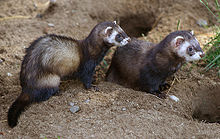European polecat: Difference between revisions
Tigershrike (talk | contribs) +cy |
|||
| Line 23: | Line 23: | ||
== Range, habitat and ecology == |
== Range, habitat and ecology == |
||
Polecats are found throughout Europe.<ref>[http://www.european-mammals.org/php/mapmaker.php Mapmaker at european-mammals.org, accessed November 2007]</ref> They are mainly nocturnal and are found in woodlands, farmlands and |
Polecats are found throughout Europe.<ref>[http://www.european-mammals.org/php/mapmaker.php Mapmaker at european-mammals.org, accessed November 2007]</ref> They are mainly nocturnal and are found in woodlands, farmlands and wetl22ands. They often make dens in stream banks or under tree roots. Almost entirely carnivorous, they feed largely on small mammals such as [[voles]] and [[rats]] and, seasonally, on [[frogs]] and [[toads]]. Small birds and insects are a much smaller component of their diet.<ref>{{cite journal |doi=10.1046/j.1442-9993.2000.01024.x |title=Functional response and area-restricted search in a predator: seasonal exploitation of anurans by the European polecat, ''Mustela putorius'' |year=2000 |author=Lode, T. |journal=Austral Ecology |volume=25 |pages=223}}</ref> They require a home range of about a square kilometre. The pattern of polecat predation on frogs was found to be sex selective and predation by polecats is found to influence sex ratio, male abundance and sexual conflict in a frog mating system, restricting the opportunity for multiple mating.<ref>{{cite journal |author=Lodé T, Holveck MJ, Lesbarrères D, Pagano A |title=Sex-biased predation by polecats influenced the mating system of frogs |journal=Proc. Biol. Sci. |volume=271 Suppl 6 |issue= |pages=S399–401 |year=2004 |month=December |pmid=15801586 |pmc=1810108 |doi=10.1098/rsbl.2004.0195 |url=}}</ref> |
||
== Reproduction == |
== Reproduction == |
||
Revision as of 19:13, 31 August 2010
| European Polecat | |
|---|---|

| |
| European Polecats | |
| Scientific classification | |
| Kingdom: | |
| Phylum: | |
| Class: | |
| Order: | |
| Family: | |
| Genus: | |
| Species: | M. putorius
|
| Binomial name | |
| Mustela putorius (Linnaeus, 1758)
| |

The European Polecat (Mustela putorius), also known as a fitch, foumart, or foulmart, is a member of the Mustelidae family, and is related to the stoats, otters, and minks. Polecats are dark brown with a lighter bandit-like mask across the face, pale yellow underbody fur, a long tail and short legs. They are somewhat larger than weasels but smaller than otters, weighing between 0.7 kg for females to 1.7 kg for males. The European Polecat is the wild ancestor of the domesticated ferret.
Range, habitat and ecology
Polecats are found throughout Europe.[2] They are mainly nocturnal and are found in woodlands, farmlands and wetl22ands. They often make dens in stream banks or under tree roots. Almost entirely carnivorous, they feed largely on small mammals such as voles and rats and, seasonally, on frogs and toads. Small birds and insects are a much smaller component of their diet.[3] They require a home range of about a square kilometre. The pattern of polecat predation on frogs was found to be sex selective and predation by polecats is found to influence sex ratio, male abundance and sexual conflict in a frog mating system, restricting the opportunity for multiple mating.[4]
Reproduction
Though polecats are chiefly polygynous, females can be polyandrous.[5] The sexual conflict of the mating system can change with environmental conditions. Sexual conflict may result in sexually antagonistic co-evolution, in which one sex evolves a "manipulative" character which is countered by a "resistance" trait in the other sex.

Hybridisation
Polecats (mainly dark phenotype) are able to hybridise with the rare European mink and have fertile hybrids.[6] In some parts of England the abandoning of domestic ferrets has led to ferret-polecat hybrids living in the wild. Often hybrids have a less distinct facial mask, light throat patches and lighter fur especially on the undersides. However there are some hybrids that are almost indistinguishable from pure polecats.
The native polecat has made a recovery across much of central and southern England thanks in part to reintroduction programmes. Recent DNA studies have shown that the pure native polecats have become firmly reestablished and are not becoming greatly hybridised.[7] It has been suggested that the hybrid animals containing domesticated ferret genes are less well adapted to life in the wild than native polecats as the hybrids tend to be distributed near or beyond the main polecat range.
Other species
Other species of polecat include the Steppe Polecat (M. eversmanii) and the European Mink (M. lutreola). Most zoologists believe that the domestic ferret (M. putorius furo) is descended from the European Polecat, or possibly from a hybrid of the European and steppe varieties. The Zorilla, also called the striped polecat (Ictonyx striatus), lives in subsaharan Africa.
References
- ^ Template:IUCN2008 Database entry includes a brief justification of why this species is of least concern
- ^ Mapmaker at european-mammals.org, accessed November 2007
- ^ Lode, T. (2000). "Functional response and area-restricted search in a predator: seasonal exploitation of anurans by the European polecat, Mustela putorius". Austral Ecology. 25: 223. doi:10.1046/j.1442-9993.2000.01024.x.
- ^ Lodé T, Holveck MJ, Lesbarrères D, Pagano A (2004). "Sex-biased predation by polecats influenced the mating system of frogs". Proc. Biol. Sci. 271 Suppl 6: S399–401. doi:10.1098/rsbl.2004.0195. PMC 1810108. PMID 15801586.
{{cite journal}}: Unknown parameter|month=ignored (help)CS1 maint: multiple names: authors list (link) - ^ Lodé, Thierry (2001). "Mating system and genetic variance in a polygynous mustelid, the European polecat". Genes & Genetic Systems. 76: 221. doi:10.1266/ggs.76.221.
- ^ Lodé T, Guiral G, Peltier D (2005). "European mink-polecat hybridization events: hazards from natural process?". J. Hered. 96 (2): 89–96. doi:10.1093/jhered/esi021. PMID 15653561.
{{cite journal}}: CS1 maint: multiple names: authors list (link) - ^ Vincent Wildlife Trust/The Mammal Society Polecat Survey 2004-2006
External links
- Animal ecology of polecat
- Waarneming.nl Pictures, sightings, distribution maps of European polecats in the Netherlands.
- European polecat (Mustela putorius) - ARKive.org

